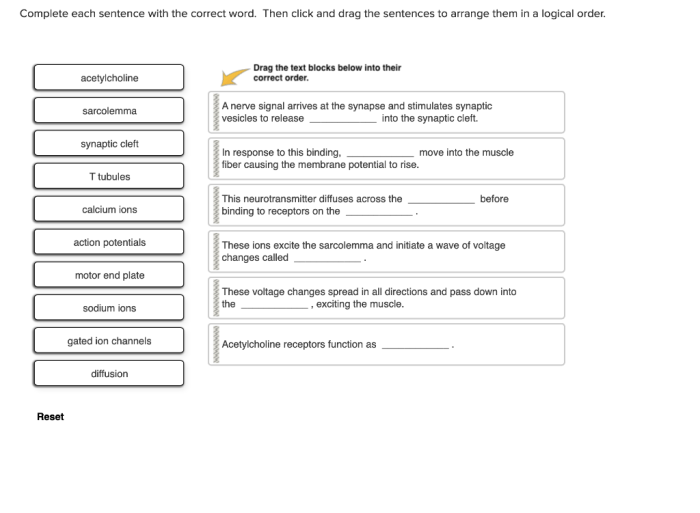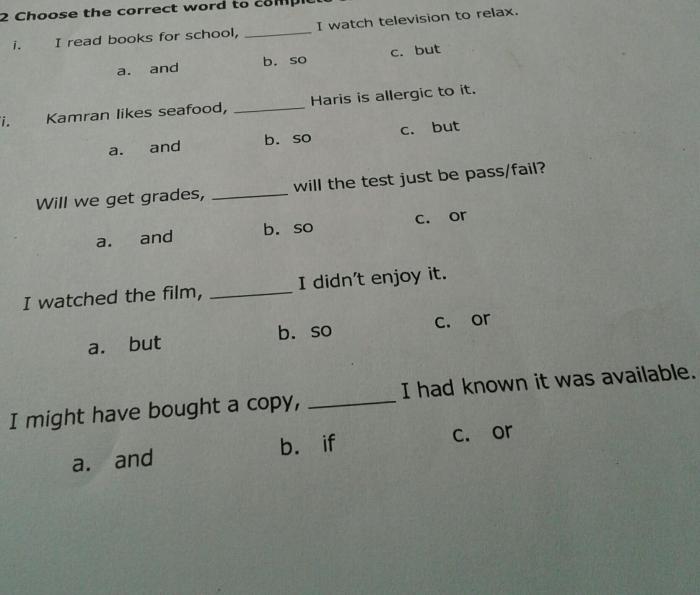Completar complete each sentence with the correct word – Completing sentences with the correct word is a crucial language skill that plays a vital role in language acquisition and communication. This multifaceted task involves a range of cognitive abilities and can be utilized for various purposes, including language assessment and teaching.
In this comprehensive guide, we delve into the different types of sentence completion tasks, explore effective methods for completing sentences, and discuss strategies for teaching this essential skill. Additionally, we examine the applications of sentence completion in language learning and provide guidance on creating engaging and challenging exercises.
Sentence Completion Tasks

Sentence completion tasks are exercises that require individuals to complete sentences by filling in missing words or phrases. These tasks vary in difficulty and can assess different cognitive skills, such as vocabulary, grammar, and reasoning.
- Easy sentence completion tasks:These tasks typically involve filling in a single word or phrase that is missing from a sentence. They are designed to assess basic vocabulary and grammar skills.
- Intermediate sentence completion tasks:These tasks require individuals to fill in a more complex phrase or clause that is missing from a sentence. They assess more advanced vocabulary and grammar skills, as well as the ability to understand the context of the sentence.
- Advanced sentence completion tasks:These tasks require individuals to complete a sentence that is missing a significant portion of the sentence. They assess higher-level cognitive skills, such as reasoning, problem-solving, and critical thinking.
Methods for Completing Sentences
There are several methods that individuals can use to complete sentences, including:
- Using context clues:Context clues are words or phrases in the sentence that provide hints about the missing word or phrase. These clues can be found in the surrounding text or in the overall context of the sentence.
- Using grammar rules:Grammar rules can help individuals determine the correct grammatical structure of the sentence and the type of word or phrase that is missing.
- Using vocabulary knowledge:Vocabulary knowledge is essential for completing sentences. Individuals need to know the meaning of the words in the sentence in order to determine the correct word or phrase to fill in the blank.
Strategies for Teaching Sentence Completion
There are several effective strategies for teaching sentence completion skills to students, including:
- Using explicit instruction:Explicit instruction involves directly teaching students the different methods for completing sentences. This can be done through classroom lessons, handouts, or online resources.
- Providing practice opportunities:Students need to have ample opportunities to practice completing sentences. This can be done through worksheets, quizzes, or games.
- Providing feedback:Feedback is essential for students to learn from their mistakes and improve their skills. Teachers should provide feedback on students’ sentence completion exercises, pointing out any errors and suggesting ways to improve.
Applications of Sentence Completion in Language Learning, Completar complete each sentence with the correct word
Sentence completion tasks can be used for a variety of purposes in language learning, including:
- Assessing language proficiency:Sentence completion tasks can be used to assess students’ overall language proficiency. They can provide insights into students’ vocabulary, grammar, and reasoning skills.
- Diagnosing areas of language weakness:Sentence completion tasks can be used to identify areas where students are struggling with language. This information can be used to develop targeted instruction to help students improve their skills.
- Teaching new vocabulary and grammar:Sentence completion tasks can be used to introduce new vocabulary and grammar concepts to students. By filling in the blanks, students can learn the meaning of new words and how to use them correctly in sentences.
Creating Sentence Completion Exercises
When creating sentence completion exercises, it is important to consider the following factors:
- The level of difficulty:The difficulty of the exercise should be appropriate for the students’ language proficiency level.
- The length of the sentences:The sentences should be long enough to provide context, but not so long that they are difficult to understand.
- The type of blanks:The blanks should be varied, including single words, phrases, and clauses.
- The availability of context clues:The sentences should provide enough context clues to help students complete the sentences correctly.
Question & Answer Hub: Completar Complete Each Sentence With The Correct Word
What are the different types of sentence completion tasks?
Sentence completion tasks can vary in difficulty and may involve completing sentences with missing words, phrases, or clauses. Some common types include cloze tests, open-ended sentence completion, and sentence combining.
How can sentence completion tasks be used in language learning?
Sentence completion tasks can be used to assess language proficiency, identify areas of language weakness, and enhance vocabulary development. They can also serve as a diagnostic tool to pinpoint specific language skills that need improvement.
What are some effective strategies for teaching sentence completion skills?
Effective strategies for teaching sentence completion skills include using context clues, grammar rules, and vocabulary knowledge. Classroom activities such as sentence building exercises, gap-filling activities, and sentence reconstruction games can enhance students’ understanding.

